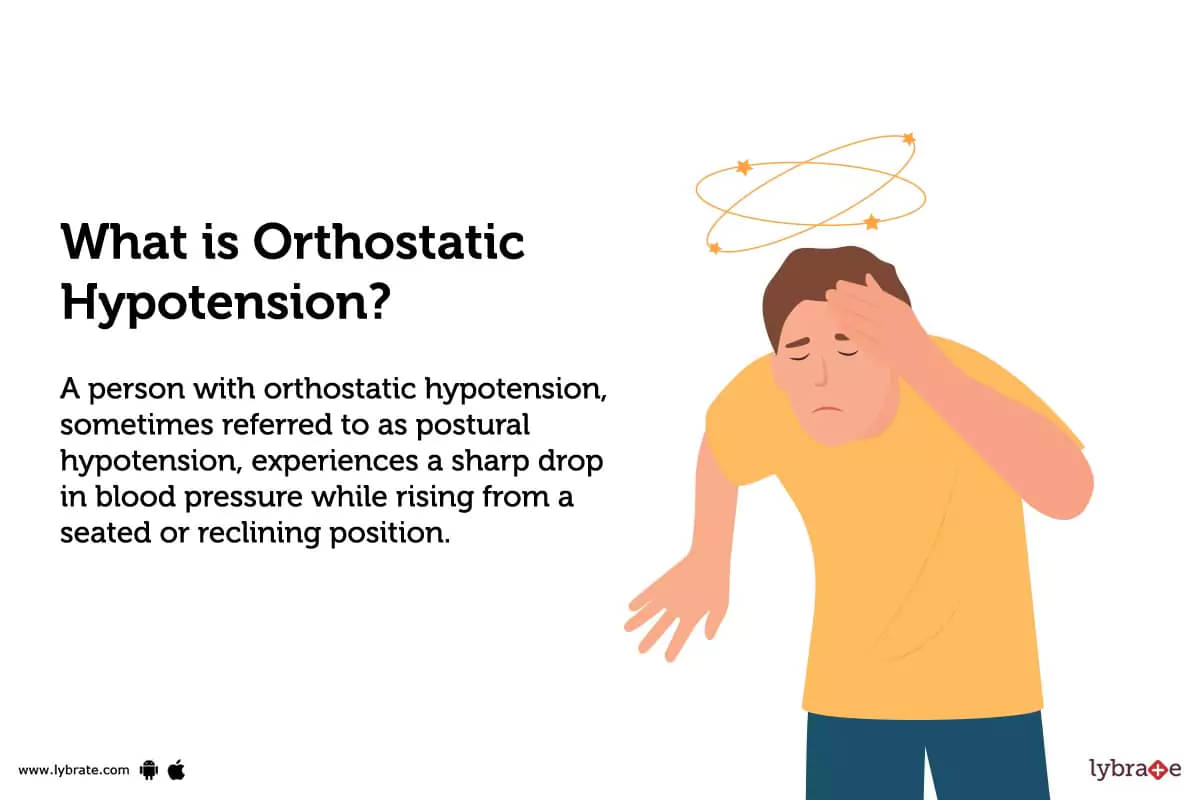Orthostatic Hypotension: Causes, Symptoms, Treatment, and Cost
Last Updated: Jul 04, 2023
What is Orthostatic Hypotension?
A person with orthostatic hypotension, sometimes referred to as postural hypotension, experiences a sharp drop in blood pressure while rising from a seated or reclining position. This may result in symptoms like fainting, dizziness, and lightheadedness.
An increase in diastolic blood pressure of at least 10 mm Hg or a decrease in systolic blood pressure of at least 20 mm Hg within 3 minutes of standing are both considered symptoms of the disorder. It occurs when the body's blood vessels do not constrict properly, causing blood to pool in the legs and leading to a decrease in blood flow to the brain.
Types of Orthostatic Hypotension
Orthostatic hypotension is a condition that can manifest itself in various forms, each with their own unique set of causes and symptoms. The most common types of orthostatic hypotension include;
Neurally Mediated Hypotension (NMH)
This particular form of orthostatic hypotension is brought on by issues with the autonomic nerve system, which regulates blood pressure in the body. Lightheadedness, wooziness, and fainting upon standing are signs of NMH.
Postural Orthostatic Tachycardia Syndrome (POTS)
This kind of orthostatic hypotension is characterized by symptoms of lightheadedness, dizziness, and fainting, as well as a rise in heart rate upon standing. The autonomic nervous system is regarded to be the root of POTS.
Drug-Induced Orthostatic Hypotension
Orthostatic hypotension is also more likely to occur when using drugs like beta blockers and diuretics. Symptoms of drug-induced orthostatic hypotension include lightheadedness, dizziness, and fainting upon standing.
What BP is Orthostatic hypotension?
When blood pressure drops by at least 20 mm Hg or at least 10 mm Hg within three minutes of standing, it is said to have orthostatic hypotension.
Who might get Orthostatic hypotension?
Anyone can develop orthostatic hypotension, but it is more common in older adults and people with certain medical conditions such as diabetes, Parkinson's disease, and autonomic neuropathy. Medications such as diuretics and beta blockers can also increase the risk of developing orthostatic hypotension.
What are the symptoms of Orthostatic Hypotension?
Orthostatic hypotension can manifest itself through a range of physical symptoms, from lightheadedness and dizziness to fainting and nausea. Understanding these symptoms is crucial in identifying and diagnosing this condition. The symptoms of orthostatic hypotension include;
Symptoms typically occur within a few minutes of standing up and may resolve quickly when the person sits or lies down.
What causes Orthostatic Hypotension?
The underlying causes of orthostatic hypotension can be complex and varied, stemming from a range of medical conditions, medications, lifestyle choices and more. Understanding these causes can help in identifying and treating the condition;
- An underlying medical condition such as diabetes, Parkinson's disease, or autonomic neuropathy
- Medications such as diuretics and beta blockers
- Dehydration
- Prolonged bed rest
- Prolonged standing
- Smoking
- Alcohol consumption
What are the Risk Factors of Orthostatic Hypotension?
Orthostatic hypotension is a condition that can affect people of all ages and backgrounds, but certain factors can increase a person's risk. Knowing these risk factors can help in identifying and preventing the condition;
- Older age
- Certain medical conditions such as diabetes and Parkinson's disease
- Taking certain medications
- Dehydration
- Prolonged bed rest
- Standing for long periods of time
How can you prevent Orthostatic Hypotension?
To prevent orthostatic hypotension, it is important to stay well-hydrated, avoid prolonged bed rest, and take breaks when standing for long periods of time. The body can respond to changes in position by gradually increasing the amount of time spent standing.
Do
- Increase the time spent standing up gradually
- When standing for extended amounts of time, take breaks
- Keep yourself hydrated
Don’t
- Stand for long periods of time without taking breaks
- Dehydrate yourself
- Suddenly stand up from a sitting or lying position
Orthostatic Hypotension - Diagnosis and Tests
Diagnosing orthostatic hypotension requires a combination of physical examination and specialized tests to accurately assess blood pressure and identify the underlying causes of the condition. Some common diagnostic tests and procedures include;
Physical examination
During a physical examination, a healthcare provider will measure blood pressure while the person is lying down and again after standing up. This can help to identify a drop in blood pressure upon standing, which is a key symptom of orthostatic hypotension.
Tilt table test
A tilt table test is a procedure that involves tilting a person's bed or table to simulate the effects of standing. To find out if orthostatic hypotension is present, blood pressure, heart rate, and symptoms are tracked throughout the test.
Blood tests
Blood tests may be used to check for underlying medical conditions that can cause orthostatic hypotension, such as diabetes or anemia.
What are possible complications of Orthostatic Hypotension?
Numerous health problems that can have a detrimental effect on a person's quality of life are brought on by orthostatic hypotension. Understanding these potential complications is crucial in identifying, treating and preventing the condition, these complications include;
- Falls
- Injuries
- Decreased quality of life
- Sign of an underlying medical condition that requires treatment
Home Remedies for Orthostatic Hypotension?
Orthostatic hypotension can be treated with home remedies that are simple and effective, from lifestyle changes to natural treatments, these remedies can provide relief from the symptoms of the condition;
- Gradually increasing the amount of time spent standing
- When standing for extended amounts of time, take breaks
- Staying well-hydrated
- Wearing compression stockings
- Avoiding dehydration
- Avoiding prolonged bed rest
- Eating a diet high in salt.
What to eat in Orthostatic Hypotension?
Eating a balanced and nutrient-rich diet can help in managing orthostatic hypotension symptoms. Eating a diet high in salt and drinking fluids can help increase blood volume and help prevent orthostatic hypotension. Drinking fluids that contain electrolytes, such as sports drinks, can also be beneficial.
Understanding which foods to include in your diet and which foods to avoid is crucial in managing this condition.
What not to eat in Orthostatic Hypotension?
Orthostatic hypotension can be caused by certain foods, so it's important to know which foods to avoid in order to manage the condition effectively. It is important to avoid caffeine, alcohol, and foods that can cause dehydration, such as processed foods and sugary drinks.
Orthostatic Hypotension Treatments
Treatment options for orthostatic hypotension may include:
Lifestyle changes
Making lifestyle changes, such as increasing fluid and salt intake, taking regular breaks when standing, and avoiding prolonged bed rest can help to prevent and manage symptoms of orthostatic hypotension.
Medications
Medications such as fludrocortisone, midodrine, and droxidopa can help to increase blood pressure and alleviate symptoms of orthostatic hypotension.
Therapy
Therapy for underlying medical conditions such as diabetes, Parkinson's disease, or autonomic neuropathy, can help to manage orthostatic hypotension.
Which doctor to consult for Orthostatic Hypotension?
Orthostatic hypotension can be diagnosed and treated by a general practitioner or a specialist like a cardiologist or neurology.
Which are the best medicines for Orthostatic Hypotension?
The effectiveness of the medications may vary from person to person based on the underlying cause of the condition and the symptoms. Medications such as fludrocortisone, midodrine, and droxidopa have been found to be effective in treating orthostatic hypotension.
It is important to consult with a healthcare provider to determine the best course of treatment, as each person's case is unique. They may also consider side effects, interactions with other medications and the patient's overall health before prescribing any medication.
How long does it take to recover from Orthostatic Hypotension?
The duration of orthostatic hypotension recovery varies depending on the underlying cause and the success of treatment. In some cases, symptoms may improve quickly with treatment, while in others, it may take longer.
Are the results of the treatment permanent?
The results of treatment for orthostatic hypotension may not be permanent, and symptoms may return if treatment is discontinued. To control the disease, it's crucial to keep collaborating with a healthcare professional.
Who is eligible for the treatment?
Anyone who is experiencing symptoms of orthostatic hypotension may be eligible for treatment.
Who is not eligible for the treatment?
People who are unable to stand or sit up due to a medical condition may not be able to participate in certain tests used to diagnose orthostatic hypotension.
What are the post-treatment guidelines?
After treatment, it's important to take a holistic approach to managing orthostatic hypotension, including monitoring blood pressure, following a healthy lifestyle and following the guidance provided by your healthcare provider. Here are some of the intrstruction that need to be followed to ensure a better recovery;
- Continue monitoring blood pressure
- Assist a healthcare professional in managing the condition
- Maintain a healthy lifestyle that includes frequent exercise and a balanced diet
- Avoid spending too much time in bed and standing for too long
- Increase the time spent standing up gradually
- When standing for extended amounts of time, take breaks
- Stay well-hydrated
- Avoid caffeine, alcohol, and foods that can cause dehydration
- When directed by the doctor, wear compression stockings
What is the price of Orthostatic Hypotension treatments in India?
The cost of treatments for orthostatic hypotension in India can vary greatly based on the specific type of treatment and the healthcare provider. Factors such as the type of treatment, the location and reputation of the healthcare provider and the duration of treatment all play a role in determining the overall cost.
To get an accurate estimate of treatment costs, it is crucial to consult with a healthcare provider and discuss the individual's specific condition and causes. The treatment plan and medication prescribed will also depend on these factors, as well as the patient's overall health, and any potential side effects or interactions with other medications.
What are side-effects of Orthostatic Hypotension treatments?
Treatment for orthostatic hypotension may cause some side-effects. Some of the most common side-effects include:
- Headaches
- Nausea
- Drowsiness
- Insomnia
- Constipation
- Dizziness
- Palpitations
- Increased heart rate
- Anxiety
- Depression
- Increased risk of falls
It is important to talk to your healthcare provider about any side-effects you may experience while undergoing treatment. Your healthcare professional could change your treatment plan if the adverse effects are severe or persistent.
Orthostatic Hypotension - Outlook / Prognosis
The prognosis for orthostatic hypotension varies based on the underlying reason and how well the treatment is working. Many times, symptoms can be controlled with medicine and lifestyle adjustments, allowing people to enjoy regular lives. Orthostatic hypotension, however, may occasionally be a symptom of a chronic medical problem that needs to be managed.
References
- Orthostatic hypotension (postural hypotension)- Mayo Clinic [Internet]. mayoclinic.org 2019 [Cited 21 August 2019]. Available from:
- Orthostatic hypotension- Genetic Home Reference, NIH, U.S. National Library of Medicine [Internet]. ghr.nlm.nih.gov 2019 [Cited 21 August 2019]. Available from:
- Orthostatic Hypotension- Cleveland Clinic [Internet]. my.clevelandclinic.org 2019 [Cited 21 August 2019]. Available from:
- Top Internal Medicine Specialist in Delhi
- Top Internal Medicine Specialist in Mumbai
- Top Internal Medicine Specialist in Gurgaon
- Top Internal Medicine Specialist in Pune
- Top Internal Medicine Specialist in Kolkata
- Top Internal Medicine Specialist in Bangalore
- Top Internal Medicine Specialist in Chennai
- Top Internal Medicine Specialist in Hyderabad
Table of content
15+ Years of Surgical Experience
All Insurances Accepted
EMI Facility Available at 0% Rate
Find Internal Medicine Specialist near me
Ask a free question
Get FREE multiple opinions from Doctors


